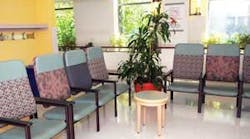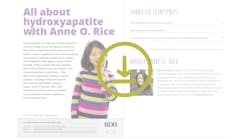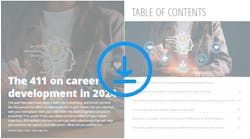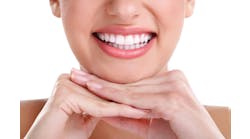Understanding today's exciting same-day chairside restorations
Although the focus of the dental hygienist is primarily preventive and periodontal care, the hygienist also can make a large impact on treatment planning and the acceptance of restorative solutions. The hygienist often sees the patient first, and the initial time spent with the patient can be a valuable investment for the patient and the practice. Relationship building through good care and communication from the hygienist fosters trust and loyalty. Good care includes knowing how to safely debride existing restorations.
Good communication includes knowledgeably talking about new restorative options and materials. It is more important than ever for the contemporary hygienist to clearly understand restorative options and dental materials.
This includes one-appointment indirect restorations using chairside computer-aided design/computer-aided manufacturing (CAD/CAM) technology. CAD/CAM restorative dentistry is expected to be one of the fastest growing markets in dentistry. A great advantage of using this technology is the ability to produce a crown, inlay, onlay, or veneer in one visit. In the near future, chairside CAD/CAM technology will allow for immediate placement of a crown on an implant. Other digital tools that have advanced esthetic dentistry are digital colorimeter technologies such as the Shade-X by X-Rite.
How Chairside CAD/CAM Dentistry Works
In order for the CAD/CAM system to be used for designing a restoration, a digital impression is taken and entered into a computerized system. When entered, the system creates a virtual model. The restoration is then designed using certain user-friendly software tools. The designed restoration is then sent either via cable or wirelessly to a milling unit in the dentist's office.
The materials used to fabricate the restoration come in blocks and include porcelain, composite, and lithium disilicate (other materials are under development). The mill contains burs that will cut the block to form the restoration. Milling a restoration usually takes between six to 20 minutes, depending on the size of the restoration, size of the block, and type of material used. The finished restoration can then be polished or stained and glazed prior to placement. If stain and glaze are applied, the restoration must be fired in an oven for about 12 minutes. With today's technology, the finished result is an esthetically beautiful and well-fitting restoration.
The first chairside CAD/CAM system, Sirona's CEREC, was introduced 20 years ago and has been updated. The CEREC system uses an infrared light to capture the optical impression. Because the infrared light is absorbed by enamel, a reflective medium must be placed on the teeth, prior to scanning. The system will create a stonelike 3D model and the restoration is designed on the model.
Recently, a new chairside CAD/CAM system was introduced. The E4D Dentist was developed and manufactured by D4D Technologies in Richardson, Texas. The E4D Dentist captures the optical impression using laser technology. In most cases, the use of the laser allows the system to capture data directly off of the tooth structure. This system is a Class 1 low level laser, which is different from lasers used to cut tissue and closer to the type of laser in a laser pointer. The E4D system also uses a very small camera, located in the handpiece, which is referred to as the Intraoral Digitizer or IOD. When scanning a model, the system creates a stonelike 3D model.
But exclusive to the E4D Dentist, when scanning the mouth, the camera takes pictures and superimposes them on the 3D model. The result is a realistic visual that allows the clinician to see even the smallest details. This is very useful when looking for the margin. As with any impression, whether material or virtual, the margin on the prepared tooth must be seen and identified in order to assure a properly fitting restoration.
Once the margin is identified, the restoration is designed and then milled. Up to seven, single restorations can be designed at one time. The system is also capable of scanning an impression. So the options are to scan in the mouth, scan the impression, or scan a model.
Convenient and Profitable Dentistry
Let's compare chairside CAD/CAM one-visit dentistry to a traditional restoration procedure. Traditional care involves at least two office visits. During the first visit, the patient is anesthetized, a shade is chosen, and the tooth is prepared.
A cord is sometimes packed around the prepared tooth in order to retract the tissue. Retracting the tissue aids in seeing the margin of the tooth on the impression. Sometimes a diode laser is used to trim the tissue around the tooth to facilitate identifying the margin.
The dental technician fabricating the restoration needs to know exactly where the margin is in order to assure that the restoration creates a tight seal around the margin of the tooth. If a margin is left open, bacteria can enter and cause recurrent decay under the restoration.
Impressions are taken, including an impression of the opposing arch to assure proper occlusion. A temporary or provisional restoration must be made and cemented using a temporary luting agent. The impressions and sometimes digital photographs are sent to the laboratory, where the dental technician will fabricate the restoration. This usually takes about two weeks, depending on the laboratory's schedule.
The patient returns to the dental office for seating of the permanent restoration, and this procedure usually requires anesthesia, also. The temporary is removed and the final restoration is seated.
Prior to seating, the restoration is placed on the preparation and checked for proper fit. Occlusal and proximal contacts are checked. If the contacts are too strong, the restoration will require adjusting, which sometimes removes some of the beautiful glaze that was applied and baked on by the technician. If the shade is not correct, the restoration does not seat, or there are open contacts, new impressions may be needed and sent back to the laboratory, and the patient would have to return for yet another visit.
With today's busy lifestyles, multiple appointments are not something most patients want for a single restoration. Though the reasons patients put off much needed dental treatment vary, in addition to the most common reason (fear), time limitations are also a frequent factor. A second or even third visit often requiring the anesthesia that patients often dread can be a further limiting factor to accepting necessary treatment. A temporary crown is just that, temporary, and has limitations. Temporaries can sometimes lead to sensitivity, come off, or contribute to other problems that require still another visit and sometimes a delay in final placement of the permanent restoration.
Obviously, a chairside CAD/CAM system can actually pay for itself. Laboratory bills, the cost of operatory turn-around, additional staff time, and materials for items such as impressions and temporaries are eliminated.
Dental practices providing chairside CAD/CAM restorations often use the system as a way to market their services.
Care of CAD/CAM Restorations
The all-ceramic, metal-free CAD/CAM restorations used today can be so natural looking that it's sometimes difficult to identify natural dentition from the restorations. It's important to consider this point, especially if polishing is part of the hygienist's protocol for a patient who's received that type of treatment.
The American Dental Hygienists' Association position paper on polishing procedures is a valuable reference for dental hygienists and dentists. Polishing should not be considered a necessary part of the oral prophylaxis for all patients. Rather, the need for polishing should be determined on an individual patient basis. If polishing is required, it should be carried out with caution.
Polishing pastes are available for new restorative materials, and these include Clinpro™ Prophy Paste from 3M ESPE and Proxyt™ from Ivoclar Vivadent. These products were developed by the same companies that produce the all-ceramic materials used in CAD/CAM restorative dentistry and are formulated for those materials. When debriding areas around CAD/CAM restorations, it's also best to use thin tips with ultrasonic scalers at a low power setting and avoid positioning the ultrasonic tips directly on the margins.
As a valuable member of the dental team, the dental hygienist is first committed to prevention. Yet, when restorations are necessary, hygienists must have a working knowledge of today's restorative options, and these now include chairside CAD/CAM restorations. Hygienists must also be aware of how to care for these restorative materials during prophylaxis and periodontal maintenance care. It's by demonstrating their excellent skills and knowledge that dental hygienists are valuable team members who make a significant impact on the success of a practice.
Author acknowledgement: I would like to thank Patti DiGangi, RDH, BS for the contribution she made in working with me to complete this article. She took the time out of her very busy schedule to help me. Her guidance, talents, and expertise are greatly appreciated.
About the Author
Annette Wolfe, RDH, BS, is the professional services specialist for D4D Technologies and a faculty member of the E4D University. Annette came to D4D Technologies in February 2007 from Dentsply Professional, where she served as clinical educator for the Southeast region. Prior to her position with Dentsply, she spent more than eight years with EMS/Electro Medical Systems. Annette received her dental hygiene degree from Texas Woman's University. Annette has written and presented continuing education courses; reviewed and revised textbook materials; provided clinical and product support for practice management organizations, dental dealers, and clinicians; and worked with numerous researchers from universities and research centers.
Reasons For a Hygienist To Support a One-Appointment Procedure are Obvious:
- Avoidance of a provisional stage
- It is often a more conservative restorative treatment
- There is routinely less direct interaction with the soft tissue, since supragingival margins are preferred and practical with all-ceramic esthetic restorations







